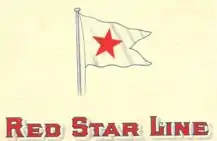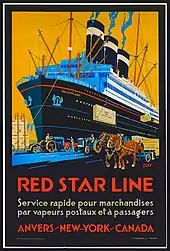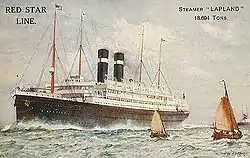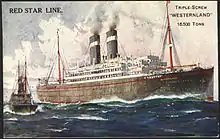 | |
| Type | Joint venture |
|---|---|
| Industry | Shipping, transportation |
| Founded | 1871 |
| Defunct | 1935 |
| Fate | Assets sold |
| Successor | Holland America Line |
Area served | Transatlantic |
The Red Star Line was a shipping line founded in 1871 as a joint venture between the International Navigation Company of Philadelphia, which also ran the American Line, and the Société Anonyme de Navigation Belgo-Américaine of Antwerp, Belgium. The company's main ports of call were Antwerp[1][2] in Belgium, Liverpool and Southampton[1] in the United Kingdom and New York City[1] and Philadelphia[3] in the United States.
History
The company was founded by Clement Griscom, who led it from its founding until the International Mercantile Marine Co. took it over in 1902. Red Star Line survived IMM's financial crisis in 1915. In the 1930s Red Star Line was part of Arnold Bernstein Line.[1]
The company declared bankruptcy in 1934.[4] It operated until 1935 when it ceased trading. Its assets were eventually sold to the Holland America Line.
Heritage

The former warehouses of the Red Star Line in Antwerp were designated as a landmark and reopened as a museum on 28 September 2013 by the City of Antwerp.[5] The main focus of the museum is the travel stories that could be retrieved through relatives of the some two million Red Star Line passengers.[6][3] In the exhibition the visitor follows the travelers' tracks from the travel agency in Warsaw until their arrival in New York. The museum exhibits works of art depicting the Red Star Line emigrants by the Antwerp artist Eugeen Van Mieghem (1875-1930), together with Red Star Line memorabilia from the collection of Robert Vervoort.[5][7]
About a quarter of the some two million Red Star Line migrants were Jews, largely from Eastern Europe until the exodus driven by the rise of Nazi Germany. Among them were many famous persons, including regular passenger Albert Einstein.[6][8] On learning of the Nazi confiscation of his possessions, Einstein chose not to return to Germany; his letter resigning from the Prussian Academy of Sciences, written on the line's stationery, is a part of the museum exhibit.[3] Other notable emigrants included the five-year-old Irving Berlin.[3]
Ships
Red Star Line ships had a black funnel with a white band bearing a five-pointed red star.[1] The house flag was a white burgee with a red star.[1]

Most Red Star ships were given names ending in "-land". Notable Red Star ships included:
- Abbotsford (1873). Chartered from Gourlay Brothers, Dundee, in 1874.
- Adria (1896). chartered from Hamburg America Line in 1899.
- Arabic (1908). Chartered from White Star Line 1926–29.
- Belgenland (1878). Sold to Italian owners in 1905 and renamed Venere.
- Belgenland (1914). Completed as troop ship Belgic for White Star Line. Transferred to Panama Pacific Line, renamed Columbia.
- Berlin (1874). Chartered from American Line for seven voyages 1895–98.
- Cambroman (1892). Built by Laird Brothers, Birkenhead. Chartered from Dominion Line for four voyages 1907.
- Conemaugh (1882). Built by Bartram, Haswell & Co of Sunderland as Sacrobosco. Bought in 1890 after salvage. 1897 transferred to New York – Seattle route, 1904 went missing at sea.
- Finland (1902). Scrapped in 1928.
- Friesland (1889). Sold to Italian owners in 1905 and renamed La Plata in 1912.
- Gothland (1893). Built for White Star Line as Gothic. Transferred to Red Star Line in 1908 and renamed Gothland. Transferred back to White Star Line in 1911 and name reverted to Gothic. Transferred again in 1913 to Red Star Line and name changed to Gothland. Scrapped in 1925.
- Kroonland (1902). Scrapped in 1927.

- Lapland (1908). Scrapped in 1934.
- Noordland (1883). Built by Laird Brothers, Birkenhead. Scrapped 1908.
- Pennland (1870). First ship of this name. Built at Glasgow by J&G Thomson & Co and launched as Algeria for Cunard Line. Sold to Red Star Line, renamed Pennland, and refitted in 1881. Went into Antwerp – New York passenger service in 1889. Scrapped in Italy in 1903.
- Pennland (1922). Launched for American Line as Pittsburgh. Transferred to Red Star Line in 1935 and renamed Pennland. Sunk in 1941 after being damaged by enemy aircraft.
- Rhynland (1879). Sold to Italian owners in 1906, renamed Rhyna and scrapped.
- Rusland (1872). Built as Kenilworth for American Line. Acquired in 1877, ran aground at Long Branch, NJ]] on 19 March 1877, subsequently broke in two and declared a total loss.[9]
- Samland (1902). Transferred from Atlantic Transport Line in 1906. Served until 1911 when it was chartered by White Star Line. Returned to Red Star Line in 1913. Scrapped in 1931.
- Vaderland (1872). Sold to France in 1879 and renamed Geographique.
- Vaderland (1900). Renamed Southland in 1915. Sunk by torpedo in 1917 with the loss of four lives.
- Waesland (1867). Built as Russia. Acquired and renamed Waesland in 1880. Transferred to American Line in 1895. Sunk in collision with Houston steamship Harmonides in 1902.
- Westernland (1884). Built by Laird Brothers, Birkenhead. An early steamship to be built of steel. She sailed the Antwerp – New York route. Transferred to American Line in 1901 and scrapped in 1912.

- Westernland (1917). Launched for White Star Line as Regina. Transferred to Red Star Line in 1929 and renamed Westernland.[10] Transferred to Bernstein Red Star Line of Hamburg in 1935. Was an Allied troop ship in the Battle of Dakar in 1940.[10]
- Zeeland (1878). Bought as Java from Cunard Line in 1878. Sold to France in 1889.
- Zeeland (1901). Launched 1900 and remained with Red Star until World War I 1914
In popular culture
The Red Star Lines appear in the Mario Puzo's The Godfather Part II when the young Vito Corleone arrives in New-York. His identification badge is from the Red Star Lines company.
The Paris football club Red Star FC are named after the Red Star Line, on which the club's founder Jules Rimet's English housekeeper had travelled.
In James Cameron's Titanic, a warehouse can be seen at the Southampton Docks labelled Red Star Line. It is seen through the window of the pub as Jack and Fabrizio are first introduced.
References
Notes
- 1 2 3 4 5 6 Harnack, 1938, page 566
- ↑ "About the Museum". Red Star Line Museum. Retrieved November 1, 2017.
- 1 2 3 4 "Museum tells of ships that took Jews to US". Ynetnews. 26 October 2013. Retrieved April 15, 2014.
- ↑ "History". Red Star Line Museum. Retrieved 1 November 2017.
- 1 2 "The Red Star Line Museum: History". Retrieved April 16, 2014.
- 1 2 "The Red Star Line Museum in a Nutshell". Retrieved April 16, 2014.
- ↑ "The Red Star Line Museum: Why Visit". Retrieved April 16, 2014.
- ↑ "The Red Star Line Museum: Stories Now and Then". Retrieved April 16, 2014.
- ↑ "Belgian Merchant H-O" (PDF). Belgische Koopvaardij. Retrieved 31 October 2010.
- 1 2 "SS Regina". Retrieved April 15, 2014.
Bibliography
- Flayhart, William (2000). The American Line. New York: W. W. Norton & Company. ISBN 0-393-04710-5.
- Harnack, Edwin P (1938) [1903]. All About Ships & Shipping (7th ed.). London: Faber and Faber. p. 566.
- Mieghem, Eugeen Van (2009). One Foot in America: The Jewish Emigrants of the Red Star Line and Eugeen Van Mieghem. Wommelgem. ISBN 9789085865292.
{{cite book}}: CS1 maint: location missing publisher (link) - Vervoort, Robert (1999). De Red Star Line. Antwerp: Pandora. ISBN 9789053251959.
External links
- Red Star Line (the ultimate resource
- Red Star Line Museum official website
- The Guardian: Across the Atlantic with the Red Star Line – in pictures – from the Red Star Line Museum
- Red Star Line, People on the move, (in Flemish)
- Passenger Lists from the Red Star Line GG Archives
- The Eugeen Van Mieghem Museum
- Red Star Line History and Ephemera GG Archives